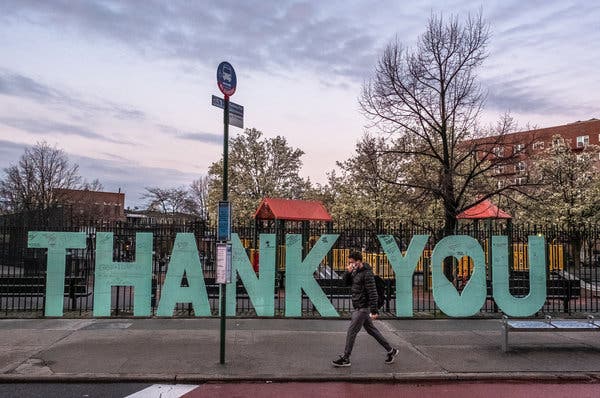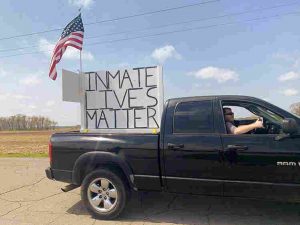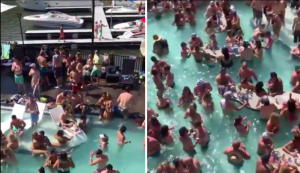Weather: Foggy early, then increasingly sunny, with a high in the mid- to upper 70s.
Alternate-side parking: Suspended through June 7.
Families of front-line workers who died will receive benefits.
New York’s state and local governments will provide death benefits to the families of essential workers who died while fighting the coronavirus, Gov. Andrew M. Cuomo said on Monday.
“We want to make sure that we remember them, and we thank our heroes of today, and they’re all around us,” Mr. Cuomo said at his daily news briefing.
As people paused on Memorial Day to remember military personnel who died while serving the country, Mr. Cuomo linked the fallen service members to New York’s front-line workers, whom he called today’s “heroes.”
The public employees whose families would receive death benefits included health workers, police officers, firefighters, transit workers and emergency medical workers, the governor said. The benefits would be paid out of state and local pension funds.
Mr. Cuomo also called on the federal government to provide funds to give hazard pay to workers who were crucial to keeping states and municipalities operating during the outbreak.
His announcement — on the deck of the U.S.S. Intrepid, an aircraft carrier turned museum anchored at the piers along the Hudson River — came as New York reported 96 new deaths related to the virus, only the second time that the state’s death toll had fallen below 100 since late March.
[Get the latest news and updates on the coronavirus in the New York region.]
New Yorkers observe Memorial Day, cautiously.
Memorial Day weekend typically serves as a peek into what the city will look like in the coming months, a taste of summer that keeps New Yorkers looking forward.
But this year, in the shadow of the coronavirus pandemic, people on Monday questioned how to gather during a crisis: Some watched socially distant processions instead of traditional parades, while others headed to the park or the beach, eager for the morning’s gray skies to clear.
In Yonkers, just north of the city, military and emergency vehicles were part of a Motorcade Memorial Day Parade. A flier encouraged onlookers to “wear a mask and practice social distancing.” On Long Island, Nassau County Executive Laura Curran hosted a car parade; residents were encouraged to watch a Facebook livestream and “salute” veterans remotely.
In New York City, beaches were still closed to swimming, though most shorelines in the region were open. Still, the relatively cool weather and public safety measures — most beaches were operating at half-capacity, and many had limited their use to locals only — dampened the urge to pack together on the sand.
[New Yorkers embark on a summer of uncertainty.]
Mayor Bill de Blasio said last week that he was considering opening beaches this summer, should the pandemic continue to ebb. And over the weekend, several members of the City Council urged the mayor to open the beaches for swimming.
“Access to city beaches isn’t just a summer fun issue,” Corey Johnson, the Council speaker, said in a statement on Saturday. “It is an equity issue and a public health issue.”
The Council set forth several recommendations for a reopening, including: flags in the sand to indicate where beachgoers can sit while social distancing; increased transportation options; and personal protective equipment and testing for lifeguards.
What we’re reading
A beginner’s guide to biking the beach. [Gothamist]
The Bushwick house share was a haven. Then Covid-19 struck. [The New Yorker]
Saratoga Springs, an upstate horse-racing mecca, is bracing for a fanless summer. [Wall Street Journal]
And finally: The original Coney Island frank
In 1867, Charles Feltman, a German immigrant, opened the first hot-dog stand in Coney Island. He called his signature frankfurter the Coney Island red hot, and it was served with mustard, sauerkraut and diced raw onions.
Soon, Feltman’s red hots were all the rage. Al Capone is said to have devoured one every night as a teenager before his shift at a local nightclub.
-
Frequently Asked Questions and Advice
Updated May 20, 2020
-
How can I protect myself while flying?
If air travel is unavoidable, there are some steps you can take to protect yourself. Most important: Wash your hands often, and stop touching your face. If possible, choose a window seat. A study from Emory University found that during flu season, the safest place to sit on a plane is by a window, as people sitting in window seats had less contact with potentially sick people. Disinfect hard surfaces. When you get to your seat and your hands are clean, use disinfecting wipes to clean the hard surfaces at your seat like the head and arm rest, the seatbelt buckle, the remote, screen, seat back pocket and the tray table. If the seat is hard and nonporous or leather or pleather, you can wipe that down, too. (Using wipes on upholstered seats could lead to a wet seat and spreading of germs rather than killing them.)
-
What are the symptoms of coronavirus?
Common symptoms include fever, a dry cough, fatigue and difficulty breathing or shortness of breath. Some of these symptoms overlap with those of the flu, making detection difficult, but runny noses and stuffy sinuses are less common. The C.D.C. has also added chills, muscle pain, sore throat, headache and a new loss of the sense of taste or smell as symptoms to look out for. Most people fall ill five to seven days after exposure, but symptoms may appear in as few as two days or as many as 14 days.
-
How many people have lost their jobs due to coronavirus in the U.S.?
Over 38 million people have filed for unemployment since March. One in five who were working in February reported losing a job or being furloughed in March or the beginning of April, data from a Federal Reserve survey released on May 14 showed, and that pain was highly concentrated among low earners. Fully 39 percent of former workers living in a household earning $40,000 or less lost work, compared with 13 percent in those making more than $100,000, a Fed official said.
-
Is ‘Covid toe’ a symptom of the disease?
There is an uptick in people reporting symptoms of chilblains, which are painful red or purple lesions that typically appear in the winter on fingers or toes. The lesions are emerging as yet another symptom of infection with the new coronavirus. Chilblains are caused by inflammation in small blood vessels in reaction to cold or damp conditions, but they are usually common in the coldest winter months. Federal health officials do not include toe lesions in the list of coronavirus symptoms, but some dermatologists are pushing for a change, saying so-called Covid toe should be sufficient grounds for testing.
-
Can I go to the park?
Yes, but make sure you keep six feet of distance between you and people who don’t live in your home. Even if you just hang out in a park, rather than go for a jog or a walk, getting some fresh air, and hopefully sunshine, is a good idea.
-
How do I take my temperature?
Taking one’s temperature to look for signs of fever is not as easy as it sounds, as “normal” temperature numbers can vary, but generally, keep an eye out for a temperature of 100.5 degrees Fahrenheit or higher. If you don’t have a thermometer (they can be pricey these days), there are other ways to figure out if you have a fever, or are at risk of Covid-19 complications.
-
Should I wear a mask?
The C.D.C. has recommended that all Americans wear cloth masks if they go out in public. This is a shift in federal guidance reflecting new concerns that the coronavirus is being spread by infected people who have no symptoms. Until now, the C.D.C., like the W.H.O., has advised that ordinary people don’t need to wear masks unless they are sick and coughing. Part of the reason was to preserve medical-grade masks for health care workers who desperately need them at a time when they are in continuously short supply. Masks don’t replace hand washing and social distancing.
-
What should I do if I feel sick?
If you’ve been exposed to the coronavirus or think you have, and have a fever or symptoms like a cough or difficulty breathing, call a doctor. They should give you advice on whether you should be tested, how to get tested, and how to seek medical treatment without potentially infecting or exposing others.
-
How do I get tested?
If you’re sick and you think you’ve been exposed to the new coronavirus, the C.D.C. recommends that you call your healthcare provider and explain your symptoms and fears. They will decide if you need to be tested. Keep in mind that there’s a chance — because of a lack of testing kits or because you’re asymptomatic, for instance — you won’t be able to get tested.
-
How can I help?
Charity Navigator, which evaluates charities using a numbers-based system, has a running list of nonprofits working in communities affected by the outbreak. You can give blood through the American Red Cross, and World Central Kitchen has stepped in to distribute meals in major cities.
-
Feltman’s hot dogs were originally made near the Brooklyn Navy Yard and sold from a pie cart. In 1871, an enormous Feltman’s restaurant opened in Coney Island. It took up two city blocks and could serve 10,000 diners at once.
It wasn’t long before other companies entered the competition. A young man named Nathan Handwerker worked for Mr. Feltman in 1915. The next year, he opened his own shop, Nathan’s Famous, down the street, where he sold his hot dogs for a nickel less.
Nathan’s ultimately became the dominant brand on the boardwalk. Feltman’s went out of business in 1954, eight years after Charles Feltman’s sons, who were in their 70s, retired and sold the business to a hotel owner.
But five years ago, Feltman’s of Coney Island returned, with two brothers once again at its helm.
Michael and Joe Quinn are relying on their complementary talents and skills to run the business — Michael is a Coney Island history buff, and Joe, who served in Iraq and Afghanistan, has the business approach of a military strategist. (For example, Joe focused on locking down the Feltman’s supply chain in January, when he first heard about the outbreak).
The brothers have also had good timing: People are pandemic-buying hot dogs like crazy.
Since March, the company has seen a 100 percent increase in sales from supermarkets and a 200 percent increase in online orders.
“Usually sales peak starting Fourth of July weekend,” Joe said. “So far it’s like March and April have turned into July.”
It’s Tuesday — savor it.
Metropolitan Diary: Doing chin-ups
Dear Diary:
I was doing my regular chin-ups on a scaffolding at Broadway and West 104th Street one afternoon when I was surrounded by four teenage boys.
“Look at the old man!” one of them said. He took out his phone and appeared to be livestreaming me in action as he and his friends pointed at me and laughed.
I was a little nervous as I finished and dropped back onto the sidewalk, but then the boys burst into applause.
“How old are you?” the one who was livestreaming asked.
“66,” I said.
He offered me his fist to bump.
“I hope I’m doing chin-ups when I’m 66,” he said.
— Dan Armstrong
New York Today is published weekdays around 6 a.m. Sign up here to get it by email. You can also find it at nytoday.com.
We’re experimenting with the format of New York Today. What would you like to see more (or less) of? Post a comment or email us: [email protected].



















